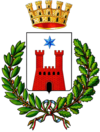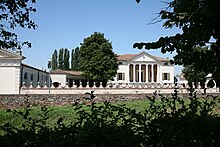Fratta Polesine
| Fratta Polesine | ||
|---|---|---|

|
|
|
| Country | Italy | |
| region | Veneto | |
| province | Rovigo (RO) | |
| Local name | Frata | |
| Coordinates | 45 ° 2 ′ N , 11 ° 39 ′ E | |
| height | 11 m slm | |
| surface | 20.90 km² | |
| Residents | 2,582 (Dec 31, 2019) | |
| Population density | 124 inhabitants / km² | |
| Post Code | 45025 | |
| prefix | 0425 | |
| ISTAT number | 029024 | |
| Popular name | Frattesi | |
| Patron saint | Peter and Paul | |
| Website | Fratta Polesine | |

Fratta Polesine is a north-eastern Italian municipality with 2582 inhabitants (as of December 31, 2019) in the province of Rovigo in Veneto . The municipality is located about 12 kilometers west-southwest of Rovigo . Since February 2011 the municipality has had the title Città (city).
history
In the late Bronze Age there was a settlement and two associated necropolises in the municipality , of which over 650 graves have been explored. This archaeological site , named after the district of Frattesina , is believed to have been between 1100 and 900 BC. One of the most important European centers of glass production. The settlement had an area of over 9 hectares and existed from around 1200 to the 8th century BC. Frattesina experienced a strong economic boom from around 1150 BC. BC, about the same time as the decline of the Terramare culture of the middle Po Valley .
The first written mention of the place as Villa Comedati took place in 1054, when it was given as a fief to the Bishop of Adria Benedict I. Around 1104 the bishops built a castle here ( Castello della Fratta , today declined ), for which the bishops fought with various nobles (e.g. the Estonians ). Often destroyed and rebuilt, it finally fell to the Pepoli , an aristocratic family from Bologna . In 1395 Fratta Polesine fell to the Republic of Venice and remained a part of it until the Peace of Campo Formio in 1797. During this time the place flourished, many wealthy Venetians chose it as their summer retreat and built villas and palaces here, such as the Villa Badoer . During the turbulent years after the French Revolution, the place fell to the Cisalpine Republic (1797-1805), then at Napoleon's Kingdom of Italy (1805-1814) and finally to the the Empire of Austria is part of Kingdom of Lombardy-Venetia . The resistance against foreign rule and the striving for national unity led many residents in the village to join the secret society of the Carbonari , many of whom were arrested in 1818. Today they are remembered by memorial plaques. In 1866 the place finally came to the Kingdom of Italy .
Community partnerships
-
 Tulcea , Tulcea County (since 2001)
Tulcea , Tulcea County (since 2001) -
 Conversano , metropolitan city of Bari
Conversano , metropolitan city of Bari
-
 Trecenta , Province of Rovigo
Trecenta , Province of Rovigo
-
 Recanati , Macerata Province
Recanati , Macerata Province
-
 Palazzolo Acreide , Syracuse Free Community Consortium
Palazzolo Acreide , Syracuse Free Community Consortium
Personalities
- Giacomo Matteotti (1885-1924), politician
traffic
Strada Statale 434 Transpolesana runs through the municipality from Verona to Rovigo. The station is also on the Verona-Rovigo railway line.
Web links
- Ministero per i Beni e le Attività Culturali, Soprintendenza per i Beni Archeologici del Veneto (ed.): Il villaggio di Frattesina e le sue necropoli - XII - X secolo aC (PDF; Guide to the finds of Frattesina in the Archaeological Museum of Fratta Polesine )
Individual evidence
- ↑ Statistiche demografiche ISTAT. Monthly population statistics of the Istituto Nazionale di Statistica , as of December 31 of 2019.
- ^ Julian Henderson : Ancient Glass: An Interdisciplinary Exploration. Cambridge University Press , February 11, 2013, p. 155 , accessed July 30, 2017 .
- ^ Anna Maria Bietti Sestieri - Jacopo De Grossi Mazzorin: Importazione di materie prime organiche di origine esotica nell'abitato protostorico di Frattesina (RO). In: P adusa Quaderni 1. Atti del I Convegno Nazionale di Archeozoologia , 1995 pp. 367-370.
- ↑ For more details: Claudio Cavazzuti et al .: Mobile elites at Frattesina: flows of people in a Late Bronze Age 'port of trade' in northern Italy. Antiquity 93, 2019, pp. 624-644.

